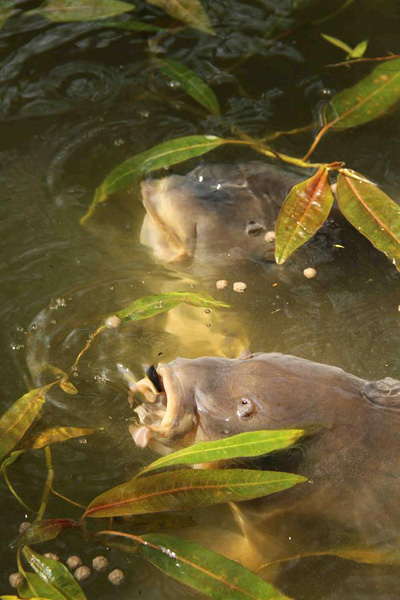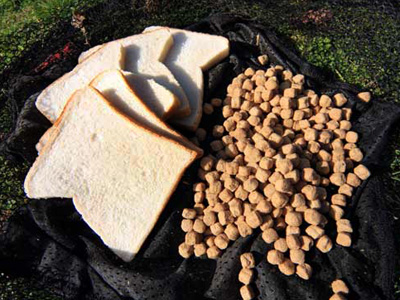As soon as the weather begins to warm up the carp start to explore the upper layers of the water in search for food and for my money surface fishing for carp is the most exciting and rewarding tactic in modern day carp fishing. The array of different methods and tricks you can adopt to tempt a bite are endless and Tackle Fanatics have put together a brief guide to make your surface angling as effective as possible.
Rods and Reels
Rods for surface fishing tend to be long and soft to allow fast line pickup, to avoid hook pulls and line breakages.
The rod you use will all depend on the size of fish you are angling for, the range you are fishing at and how much fun you want to have. For those wishing to fish using free lining, a short through action rod is perfect due to its ability to absorb the initial lunge when hooking a marginal monster. For fishing at longer range with controller floats you will require a longer 12-13ft rod with a semi-fast action and a soft tip. A longer rod will also help you mend the line, control your end tackle and strike effectively.
The reel you use for surface fishing doesn’t have to be as specialist as the rod; providing that it has a decent line capacity, is lightweight and has a precise drag system then it will be suitable for catching carp off the top.
On the other hand the line you load your reels with is instrumental, strong, low diameter mono or floating braid are highly recommended. Mono lines of between 6-12lb are typical and braid is best in 15-30lb strains. Mono line gives the angler a buffer when playing fish and you are less likely to experience hook pulls but braid is different and gives you the advantage of better control over your end tackle and the ability to make direct contact when you strike at long range.
Accessories and Terminal Tackle
 The most important accessory for surface fishing has to be a good pair of Polarised sunglasses. These special glasses take the glare off the surface of the water, enabling you to locate and observe your quarry.
The most important accessory for surface fishing has to be a good pair of Polarised sunglasses. These special glasses take the glare off the surface of the water, enabling you to locate and observe your quarry.
Terminal tackle is essential to successful surface angling; finesse is a must to help you get that all important bite when angling in the upper layers. Finley tuned fishing tackle will make the difference between you tricking that wary old beast and the hookbait being ignored completely. Although you need to try and fish as fine as possible it is unsafe to fish tiny hooks and ultra-light hooklinks as it is extremely unlikely that you will land anything. Recommended hook sizes are between 6-12 for general pellet/biscuit type fishing but you are able to use larger hooks for baits such as bread.
Hooklengths are also a vital part of the surface angler’s armoury, the length, breaking strain and nature of the material make all the difference when trying to trick large carp. The hooklink must either have neutral buoyancy, or float, to prevent spooking fish when they are feeding on the surface. Lines with a breaking strain of 6-12lb are typical and will cover the majority of situations.
Fishing at distances beyond 15m a float will be required to give you the additional casting weight and bite indication. There are a huge array of floats available on the market – these are normally referred to as controller floats. The style, size and weight will all depend on the range, depth of water and fish you are angling for. The best way to determine which float is best for you is to ask in your local tackle shop as they will be able to offer advice as which one will suit your fishing best. Remember a float is not just there to help cast, the float will often give you the tell tale sign of a bite, will assist in the control of your end tackle and in some cases will hook the fish too.
Baits, Feeding and Hookbaits
The bait you use and the way you feed is essential to successful surface angling. Often the best way is to feed little and often to get fish competing for food and after a while you can create a situation whereby the fish have ‘thrown caution to the wind’ and are so intent on getting the next bait that they become unaware of the presence of you and your rig. On the other hand a single hookbait precisely placed will sometimes fool a wary fish due to carps’ opportunistic nature.
 Surface baits come in all manner of shapes, sizes and forms; these range from dog biscuits, bread and floating paste to dedicated surface fishing baits such as buoyant trout pellets and pop-up boilies. Try mixing up the sizes of your bait to keep the carp guessing as this will prevent them from picking out your hook bait.
Surface baits come in all manner of shapes, sizes and forms; these range from dog biscuits, bread and floating paste to dedicated surface fishing baits such as buoyant trout pellets and pop-up boilies. Try mixing up the sizes of your bait to keep the carp guessing as this will prevent them from picking out your hook bait.
There are a large number of ways to feed your freebies; generally a catapult will suffice but sometimes when fishing at distance a spod or Spomb are required to get your free offerings out to fish feeding a long range. Alternative methods such as loading PVA bags with your chosen bait and catapulting them out will increase the range you can fish your free offerings.
Hookbaits are one of the most important aspect of floater fishing; if the bait is not buoyant enough or is too buoyant then a fish might shy away from it due to it behaving unnaturally. Competitive feeding will assist in fish being more willing to ignore these factors but making sure your hook bait looks and behaves like a free offering will often get your more bites.
Surface fishing is truly the most exciting, frustrating and rewarding method in carp fishing. If the weather is warm then why not get down your local lake, river or canal and try your hand at this exhilarating method!













